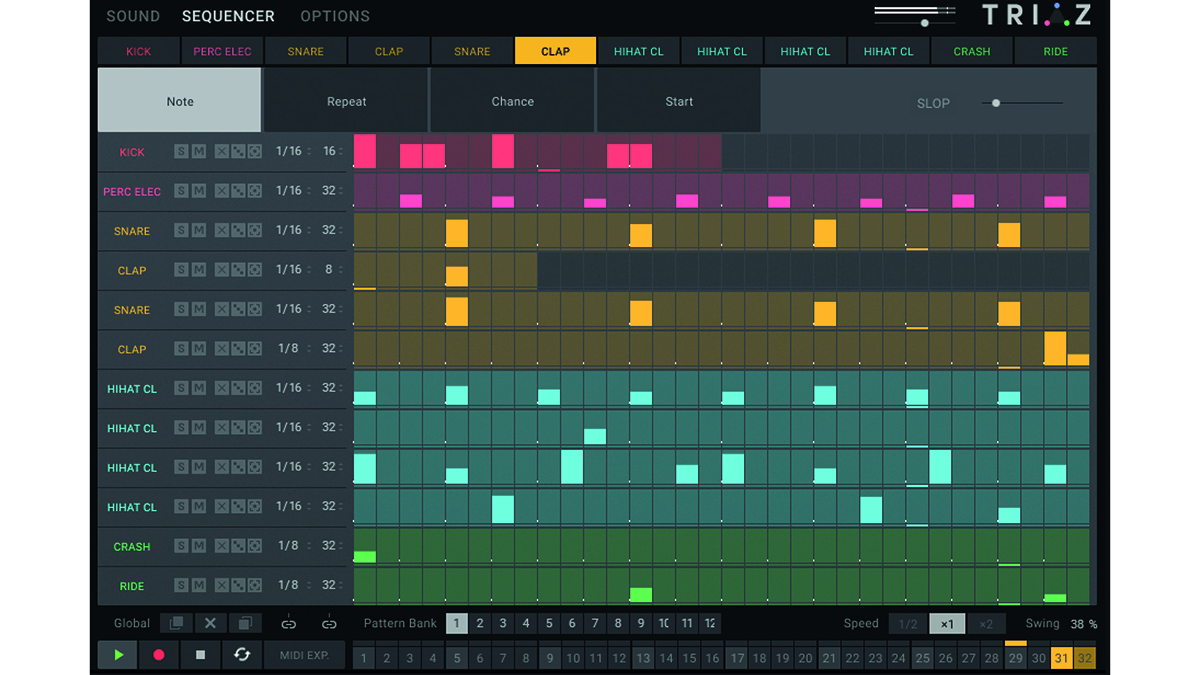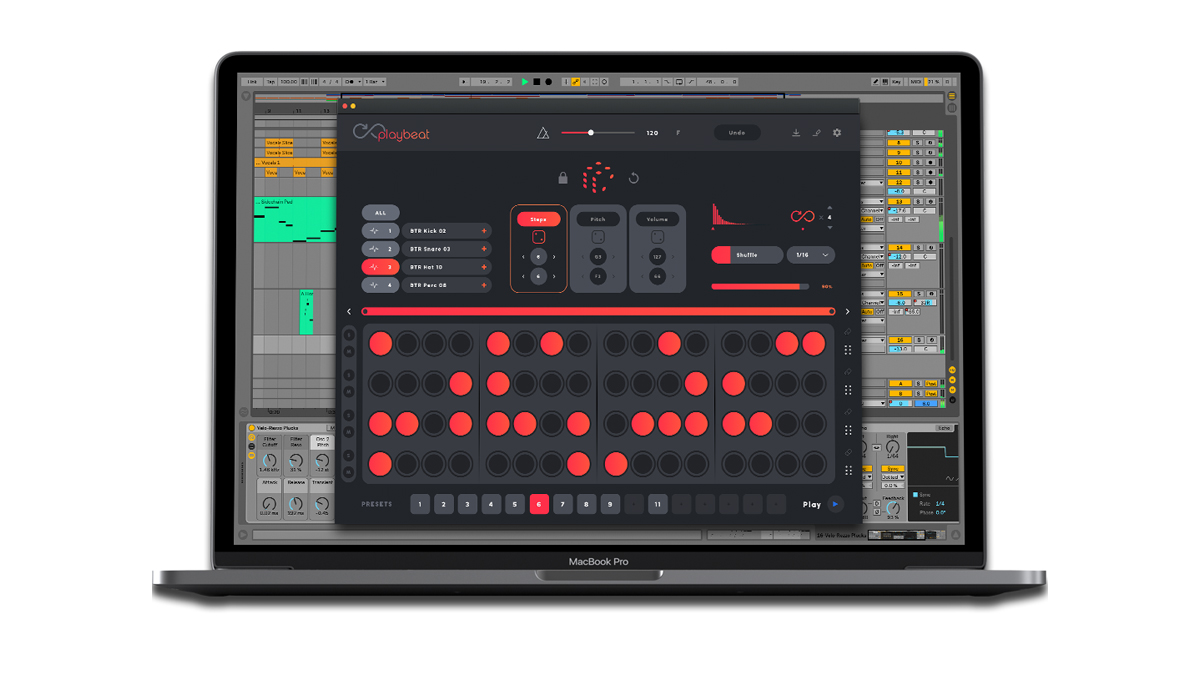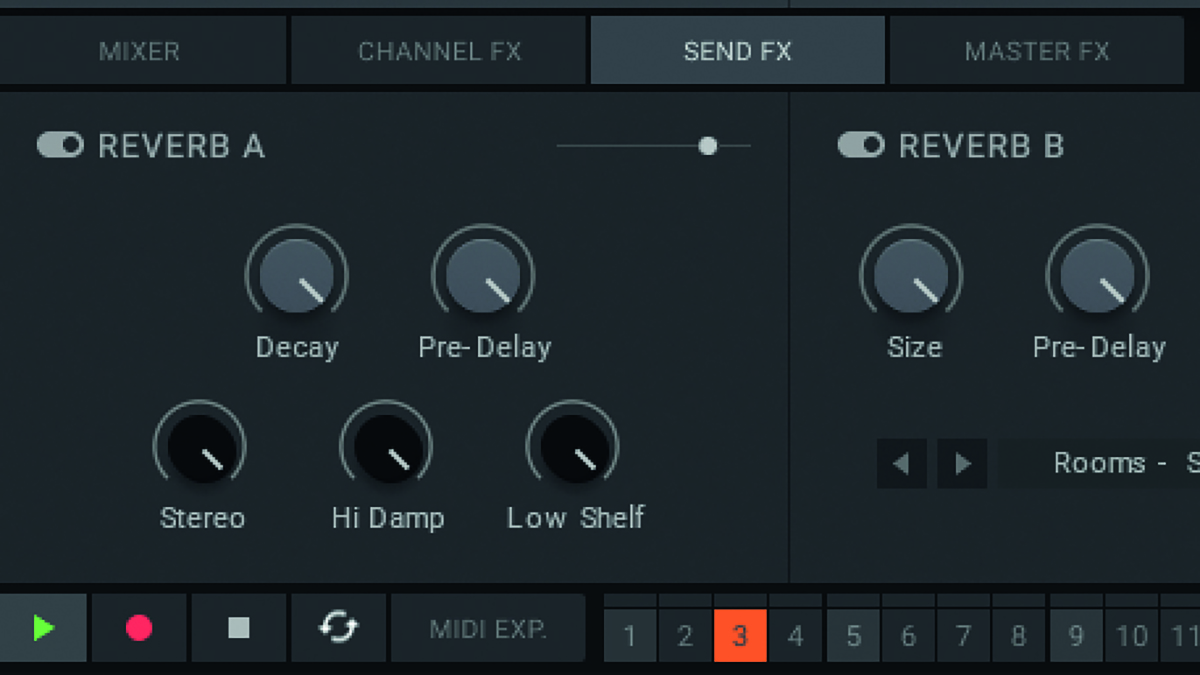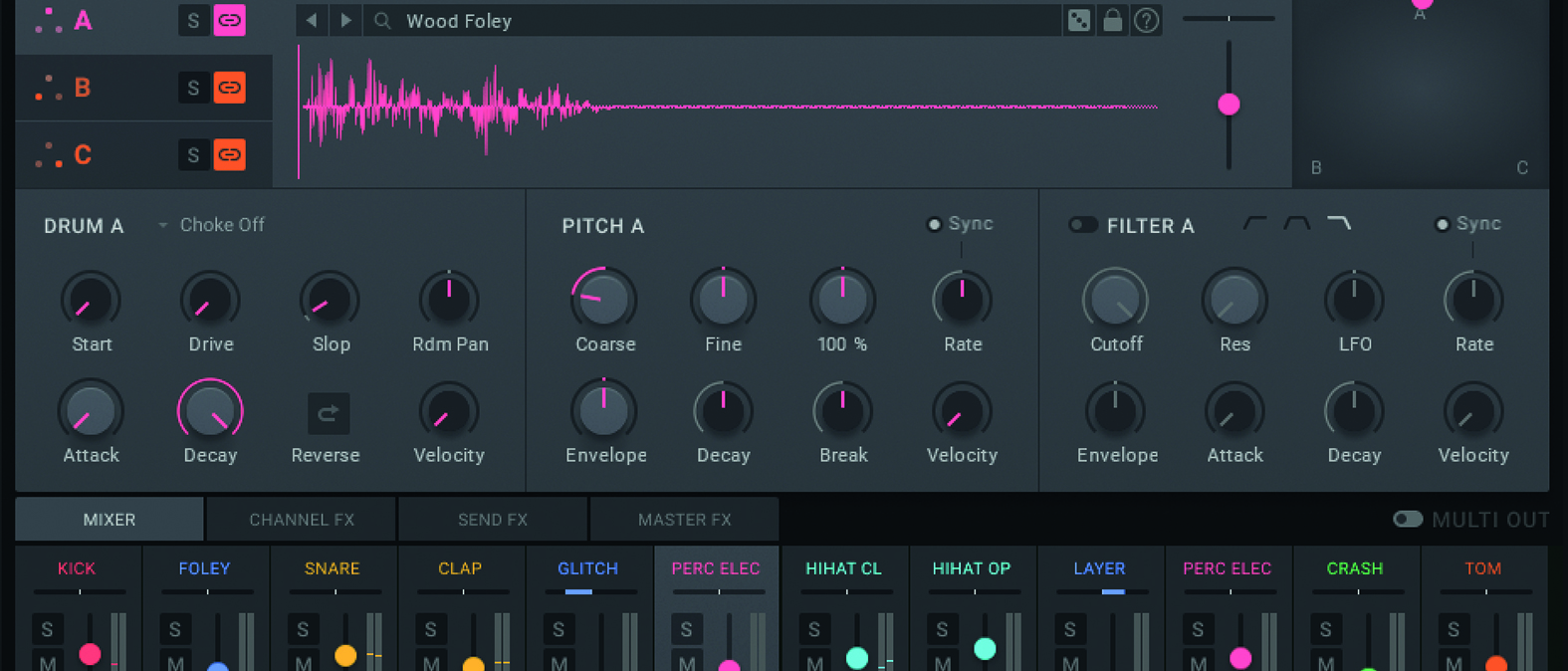MusicRadar Verdict
Looking to get deeper into the sonic nitty-gritty of your drum texture? Or simply looking for a smooth and scaleable drum machine to boost your track-building? Triaz will serve you very well.
Pros
- +
Innovative triple-layered drum designer, that positively invites creative sound design.
- +
Smart and flexible sequencer can build all manner of rhythmic movement.
- +
A huge amount of presets, ready to scale to your project with ease.
Cons
- -
Presets don’t offer many acoustic options for the non EDM-inclined out there.
MusicRadar's got your back
Wave Alchemy Triaz: What is it?
We’ve seen a lot of virtual drum machines pass through our doors in recent months, but none of which have forced us to dwell on the textures of our drum sounds quite as much as Triaz, the new multi-layered, drum-crafting and sequencing nerve centre from Wave Alchemy.
Boasting more than 10,000 individual samples and more than 600 instantly playable presets, Triaz is a tempting package right from the outset. But, taking a look at just how its three-headed sound engine works makes us aware that there’s more cleverness going on here than you might first think…
Tri harder
Wave Alchemy named Triaz for its triple-layered sound engine. But first, let’s pull back a little to give that some context. Triaz offers 12 distinct drum voices (or drum channels, if you like) per kit, which can include typical parts, such as kick, snare, hi-hat, and also genre-specific ingredients like electronic percussion and even Foley or found sounds.
Your sample’s character is shaped by how you blend, balance and modify each of these layers
Each one of these drum samples can incorporate up to three independent sound layers. This means that your sample’s character is shaped by how you blend, balance and modify each of these layers.
Ostensibly then, your drum hits become almost entirely mouldable. This more sound-design-centric way of thinking about your drum hits may come across as a little over-convoluted to some minds, but adjusting the temperament of your sound by simply dragging a small dot around an X/Y triangle that sits on the left-hand side is reassuringly smooth, visually slick and – pretty much immediately – sonically rewarding. And each of these layers can be soloed or linked as well.
While Wave Alchemy’s huge library of drum sounds (neatly tagged into 16 drum types with 20 tags each) are all pre-constructed in this way, you’re also encouraged to throw in your own samples and loops, using them as the basis to build a brand new drum sound. A simple drag and drop of a file into one of your layer engines and you’re ready to go.
So far, so fluid, but that’s far from the end of the story; Triaz’s control section adjusts on the fly to whichever layer you currently have open, allowing you to quickly tweak your layer sound by upping the attack, drive, decay, velocity and more, with heaps of scalability.
Wave Alchemy Triaz: Performance and verdict
While the amount of per-drum control is somewhat staggering, the snazzy, pre-colour-coded mixer presents a means to tie your kit together, with volume fader, pan controls and send effects available for each drum voice.
While per-drum control is staggering, the snazzy, pre-colour-coded mixer lets you tie your kit together
There’s a neat ‘autosampler’-type feature too, whereby pressing a small keyboard icon for one of your drum sounds allows it to be instantly mapped on your MIDI keyboard to be performed chromatically – if you needed just another thousand options with which to perfectly pitch your percussion.
If you’d rather take a roll of the dice and let Triaz build a fresh kit for you, then accessing the randomisation options brings an immediate shake-up of whichever kit you’re working with. You can apply this to Triaz’s presets too, leading to a virtually unlimited supply of fresh drum sound ideas.
Triaz also supports multi-output routing, so your distinct drum elements feed through to your parent DAW as individual stems. This is particularly perfect for professionals needing to deliver their complete mixes within a standard multitrack framework.

Launch sequence
A major facet of Triaz is its Sequencer. While a ‘classic’ sequencer presents simplistic note sequencing across the board, opening the Sequencer Page brings you into a world of colourful interlocking patterns. This sequencer – aside from being one of the most visually arresting ones we’ve played with of late – is extremely slick, and serves up some interesting deviations from the norm, including the crucial ability to sequence each drum voice independently of each other.

• Audiomodern Playbeat 3
A very capable creative generator for beat-making ideas. It smartly adjusts itself to how you work, too.
• Wave Alchemy Revolution
Re-craft some major heritage synths into your own personalised music machine.
This page presents four programming modes, there’s the straightforward note sequencer, a Repeat sequencer allows the easy drawing-in of repeats and stutters, while the most creatively stimulating of all, the Chance sequencer, creates randomised variations of your pattern with each cycle. This led us down some extremely unconventional, but idea-sparking, avenues.
The other sequencer is dubbed ‘Start’, which allows us to work around the quantise grid on a per-channel basis. We can use this to add off-beats, pre-delay and more unusual fills. Using this, in conjunction with the Chance sequencer injects pleasing levels of humanisation – something that is far too easy to omit when swimming in the sample domain.
Flams, pace, space
Another cool addition to Triaz’s arsenal is its immersive dual reverb module, with the first one (A) being a traditional algorithmic plate reverb emulation, and the second one (B) a tasty convolution reverb.

The convolution is pre-loaded with a nice selection of impulse responses (40 in total) which capture a range of classic analogue and digital reverb units, real locations and pro-level drum rooms. All of which – as any serious beat-maker will tell you – can be that vital glue that holds a track together. After being captured, Wave Alchemy’s impulse responses are then processed with vintage transistor and tube EQs, to wring out their aural finesse.
While a nice blend of the two is often the best route, scanning these impulse responses can land you into some exquisite spaces, such as ‘Cinema Drums’ or the atmosphere-heightening ‘Drum Enhance’. Cycle through and be amazed at how the IR’s essence informs the drum sound.
Verdict
With such a flexible sequencer, coupled with the bottomless depths of its drum channel sound blending and manipulation, it’s hard to see how Triaz could be improved. While we’ve talked about the software’s acumen as a versatile creative tool, the fact that it comes pre-loaded with a huge array of ace drum sounds is the icing on this appetising, triangular cake.
As a creative workstation, Triaz excels as a competent sound design processor, a peerless polyrhythmic generator and an idea-forming beat-hub. Meanwhile, for those in need of some track-ready, pro-sounding oomph, Triaz’s presets and sample library are faultless. While the majority of these sounds are distinctly ‘electronic’, there’s nothing stopping you from throwing in your acoustic pro drum recordings, or even just recordings of your hands rapping on a table. With Triaz, any sound can be beautifully moulded into a robust beat.
MusicRadar verdict: Looking to get deeper into the sonic nitty-gritty of your drum texture? Or simply looking for a smooth and scaleable drum machine to boost your track-building? Triaz will serve you very well.
Wave Alchemy Triaz: The web says
"The superb Triaz library is a triumph, with a large variety of sounds that make it relevant for any genre."
MusicTech
Wave Alchemy Triaz: Hands-on demos
Wave Alchemy
Red Means Recording
sonicstate
Plugin Boutique
Wave Alchemy Triaz: Specifications
- Available in Standalone, VST, AU and AAX formats. TRIAZ is powered by FREE Kontakt Player from Native Instruments. Full version of Kontakt is not required.
- Native support for Apple Silicon chips (M1).
- Supports Mac OS X 10.13 (or higher) and Windows 7 (or higher).
- Runs in Kontakt Free Player or Kontakt version 6.6 (or higher).
- 3GB in size after unpacking.
- CONTACT: Wave Alchemy
Computer Music magazine is the world’s best selling publication dedicated solely to making great music with your Mac or PC computer. Each issue it brings its lucky readers the best in cutting-edge tutorials, need-to-know, expert software reviews and even all the tools you actually need to make great music today, courtesy of our legendary CM Plugin Suite.
“I have an original 909 – every time I try to use it I feel like I’m ruining it”: House hero Riva Starr on his studio essentials and his love of analogue synths
“A synthesizer that is both easy to use and fun to play whilst maintaining a decent degree of programming depth and flexibility”: PWM Mantis review
“I feel like that song had everything we needed to come back with”: Bring Me The Horizon’s Lee Malia on Shadow Moses, its riff and the secrets behind its tone, and why it was the right anthem at the right time











